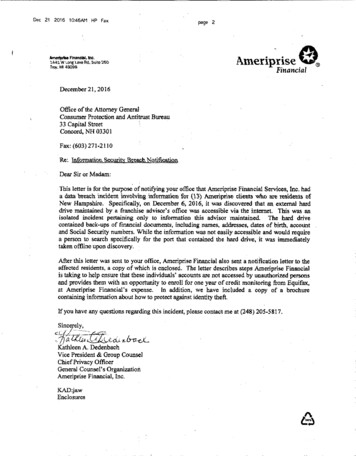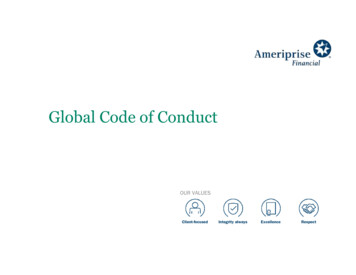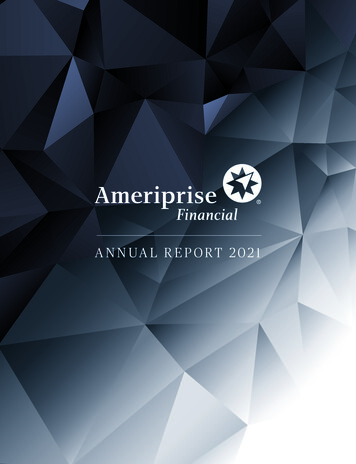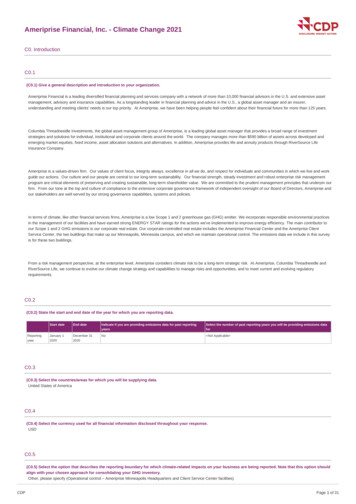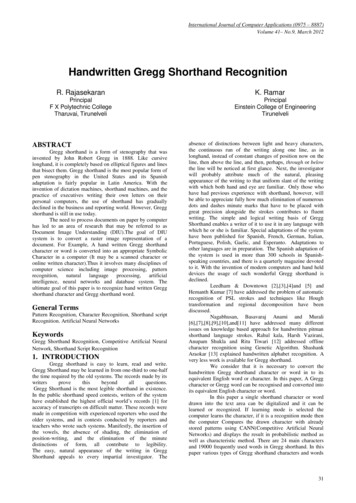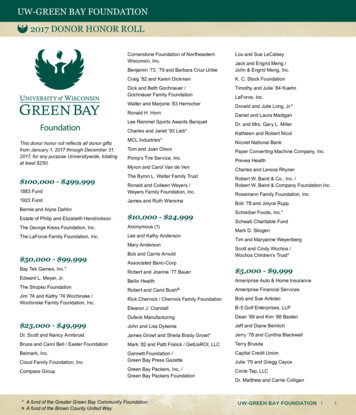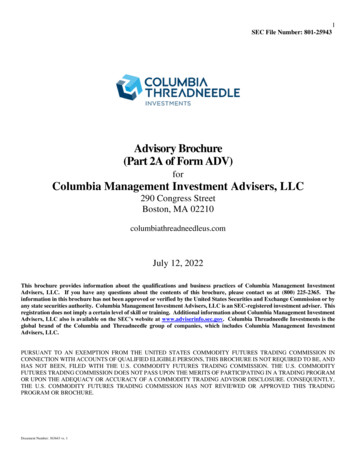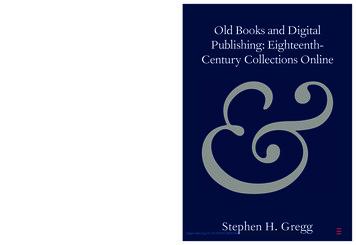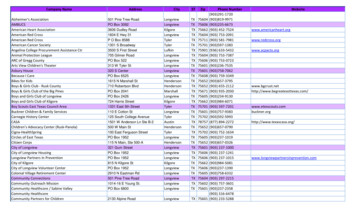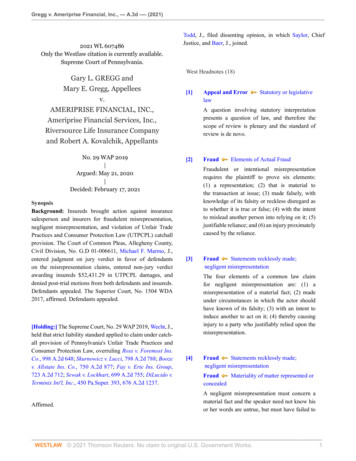
Transcription
Gregg v. Ameriprise Financial, Inc., --- A.3d ---- (2021)2021 WL 607486Only the Westlaw citation is currently available.Supreme Court of Pennsylvania.Gary L. GREGG andMary E. Gregg, Appelleesv.Todd, J., filed dissenting opinion, in which Saylor, ChiefJustice, and Baer, J., joined.West Headnotes (18)[1]AMERIPRISE FINANCIAL, INC.,Ameriprise Financial Services, Inc.,Riversource Life Insurance Companyand Robert A. Kovalchik, AppellantsNo. 29 WAP 2019 Argued: May 21, 2020 Decided: February 17, 2021SynopsisBackground: Insureds brought action against insurancesalesperson and insurers for fraudulent misrepresentation,negligent misrepresentation, and violation of Unfair TradePractices and Consumer Protection Law (UTPCPL) catchallprovision. The Court of Common Pleas, Allegheny County,Civil Division, No. G.D 01-006611, Michael F. Marmo, J.,entered judgment on jury verdict in favor of defendantson the misrepresentation claims, entered non-jury verdictawarding insureds 52,431.29 in UTPCPL damages, anddenied post-trial motions from both defendants and insureds.Defendants appealed. The Superior Court, No. 1504 WDA2017, affirmed. Defendants appealed.[Holding:] The Supreme Court, No. 29 WAP 2019, Wecht, J.,held that strict liability standard applied to claim under catchall provision of Pennsylvania's Unfair Trade Practices andConsumer Protection Law, overruling Ross v. Foremost Ins.Co., 998 A.2d 648; Skurnowicz v. Lucci, 798 A.2d 788; Boozev. Allstate Ins. Co., 750 A.2d 877; Fay v. Erie Ins. Group,723 A.2d 712; Sewak v. Lockhart, 699 A.2d 755; DiLucido v.Terminix Int'l, Inc., 450 Pa.Super. 393, 676 A.2d 1237.Affirmed.Appeal and ErrorlawStatutory or legislativeA question involving statutory interpretationpresents a question of law, and therefore thescope of review is plenary and the standard ofreview is de novo.[2]FraudElements of Actual FraudFraudulent or intentional misrepresentationrequires the plaintiff to prove six elements:(1) a representation; (2) that is material tothe transaction at issue; (3) made falsely, withknowledge of its falsity or reckless disregard asto whether it is true or false; (4) with the intentto mislead another person into relying on it; (5)justifiable reliance; and (6) an injury proximatelycaused by the reliance.[3]FraudStatements recklessly made;negligent misrepresentationThe four elements of a common law claimfor negligent misrepresentation are: (1) amisrepresentation of a material fact; (2) madeunder circumstances in which the actor shouldhave known of its falsity; (3) with an intent toinduce another to act on it; (4) thereby causinginjury to a party who justifiably relied upon themisrepresentation.[4]FraudStatements recklessly made;negligent misrepresentationFraudMateriality of matter represented orconcealedA negligent misrepresentation must concern amaterial fact and the speaker need not know hisor her words are untrue, but must have failed to 2021 Thomson Reuters. No claim to original U.S. Government Works.1
Gregg v. Ameriprise Financial, Inc., --- A.3d ---- (2021)make a reasonable investigation of the truth ofthese words.[5][6][7]Antitrust and Trade Regulationdeceit; knowledge and intentbeing premised upon intent, misrepresentationthat has the tendency or capacity to deceive is adeceptive act under federal law. 15 U.S.C.A. §41 et seq.Fraud;Strict liability standard applied to claim undercatch-all provision of Pennsylvania's UnfairTrade Practices and Consumer Protection Law,overruling Ross v. Foremost Ins. Co., 998 A.2d648; Skurnowicz v. Lucci, 798 A.2d 788; Booze v.Allstate Ins. Co., 750 A.2d 877; Fay v. Erie Ins.Group, 723 A.2d 712; Sewak v. Lockhart, 699A.2d 755; DiLucido v. Terminix Int'l, Inc., 450Pa.Super. 393, 676 A.2d 1237. 73 Pa. Stat. Ann.§ 201-2(4)(xxi).[10]StatutesLanguage and intent, will,purpose, or policy[11]Antitrust and Trade Regulationdeceit; knowledge and intentFraud;StatutesPlain Language; Plain, Ordinary,or Common MeaningAntitrust and TradeRegulationConfusionThe best indication of legislative intent is theplain language of the statute.The catchall provision of Pennsylvania's UnfairTrade Practices and Consumer Protection Lawimposes liability on commercial vendors whoengage in conduct that has the potentialto deceive and which creates a likelihoodof confusion or misunderstanding; neithercarelessness nor intent is required when a causeof action is premised upon deceptive conduct. 73Pa. Stat. Ann. § 201-2(4)(xxi).StatutesmeaningsClarity and ambiguity; multipleAntitrust and Trade Regulationand construction in generalPurposePennsylvania's Unfair Trade Practices andConsumer Protection Law must be construedliberally because it is a remedial statute. 73 Pa.Stat. Ann. § 201-1 et seq.[9]Fraud;The test for deceptive conduct under thecatchall provision of Pennsylvania's UnfairTrade Practices and Consumer Protection Law iswhether the conduct has the tendency or capacityto deceive; this test is a lesser, more relaxedstandard than that for fraudulent or negligentmisrepresentation. 73 Pa. Stat. Ann. § 201-2(4)(xxi).When the words of a statute are clear and freefrom all ambiguity, they are presumed to be thebest indication of legislative intent.[8]Antitrust and Trade Regulationdeceit; knowledge and intentAntitrust and Trade Regulationdeceit; knowledge and intentFraud;Under the Federal Trade Commission Act(FTCA), deception is a broader concept ofmisconduct than common law fraud, and requiresno proof of the actor's state of mind; rather than[12]Antitrust and Trade Regulationdeceit; knowledge and intentFraud;Antitrust and TradeRegulationConfusionUnder the catchall provision of Pennsylvania'sUnfair Trade Practices and Consumer ProtectionLaw, deceptive conduct during a consumertransaction that creates a likelihood of confusionor misunderstanding and upon which theconsumer relies to his or her financial detrimentdoes not depend upon the actor's state of mind.73 Pa. Stat. Ann. § 201-2(4)(xxi). 2021 Thomson Reuters. No claim to original U.S. Government Works.2
Gregg v. Ameriprise Financial, Inc., --- A.3d ---- (2021)[13]Antitrust and TradeRegulationReliance; causation; injury,loss, or damageLike other strict liability offenses, liability fordeceptive conduct under the catchall provisionof Pennsylvania's Unfair Trade Practices andConsumer Protection Law cannot be excusedif consumers rely upon that conduct to theirfinancial detriment. 73 Pa. Stat. Ann. § 201-2(4)(xxi).[14]StatutesExpress mention and impliedexclusion; expressio unius est exclusio alteriusWhere a section of a statute contains a givenprovision, the omission of such a provision froma similar section is significant to show a differentlegislative intent.[15]StatutesAbsent terms; silence; omissionsA court does not add a state of mind requirementto a statute where the legislature did not chooseto do so.[16]Antitrust and TradeRegulationRepresentations, assertions,and descriptions in generalThe actor's state of mind as to either the truthor falsity of the representation or the effect thatthe misrepresentation will have on the consumeris irrelevant under the catchall provision ofPennsylvania's Unfair Trade Practices andConsumer Protection Law. 73 Pa. Stat. Ann. §201-2(4)(xxi).[17]Antitrust and Trade Regulationdeceit; knowledge and intentFraud;Where a consumer protection statute is silent asto the requisite state of mind, the statute requiresneither intent to deceive nor negligence withregard to the effect of the misrepresentation.[18]Antitrust and Trade Regulationdeceit; knowledge and intentFraud;Fraud and deceptive conduct are alternative waysto establish a violation of the catch-all provisionof Pennsylvania's Unfair Trade Practices andConsumer Protection Law. 73 Pa. Stat. Ann. §201-2(4)(xxi).Appeal from the Order of the Superior Court enteredSeptember 12, 2018 at No. 1504 WDA 2017, affirmingthe Judgment of the Court of Common Pleas of AlleghenyCounty entered September 27, 2017 at No. GD 01-006611.Marmo, Michael F., JudgeAttorneys and Law FirmsCasey Alan Coyle, Esq., Eckert Seamans Cherin & Mellott,LLC, for Pennsylvania Builders Association, Amicus Curiae.Michael D. Donovan, Esq., Donovan Litigation Group,LLC, for National Consumer Law Center, NationalAssociation of Consumer Advocates, Community LegalServices, Americans for Financial Reform EducationFund, Community Justice Project, Consumer Federationof America, Legal Aid of Southeastern Pennsylvania,Neighborhood Legal Services, Pennsylvania Legal AidNetwork, Inc., Pennsylvania Legal Assistance Center, AmiciCuriae.James Lee Goldsmith, Esq., Michael Donahoo Reed, Esq.,Mette Evans & Woodside, PC, for Pennsylvania Associationof Realtors, Amicus Curiae.Howard Greeley Hopkirk, Esq., Pennsylvania Office ofAttorney General, for Attorney General, Amicus Curiae.Michael Lee Kichline, Esq., Dechert LLP, for PennsylvaniaCoalition for Civil Justice Reform, Pennsylvania BankersAssociation, Pennsylvania Health Care Association,Pennsylvania Manufacturers' Association, University ofPittsburgh Medical Center, American Property CasualtyInsurance Association, American Tort Reform Association,Chamber of Commerce of the United States of America,National Federation of Independent Business, Amici Curiae.Mark E. Milsop, Esq., Berger and Green, P.C., forPennsylvania Association for Justice, Amicus Curiae. 2021 Thomson Reuters. No claim to original U.S. Government Works.3
Gregg v. Ameriprise Financial, Inc., --- A.3d ---- (2021)Kathy Kay Condo, Esq., for Riversource Life InsuranceCompany, Ameriprise Financial, Inc., Ameriprise FinancialServices Inc., Kovalchik, Robert A., Appellants.Kenneth Robert Behrend, Esq., Behrend Law Group LLC, forGregg, Gary L., Gregg, Mary E., AppelleesSAYLOR,C.J.,BAER,TODD,DOUGHERTY, WECHT, MUNDY, JJ.DONOHUE,OPINIONJUSTICE WECHT*1 In 1999, Gary and Mary Gregg sought the expertiseof Robert A. Kovalchik, a financial advisor and insurancesalesperson for Ameriprise Financial, Inc. Engaging inwhat the trial court would later conclude to be deceptivesales practices, Kovalchik made material misrepresentationsto the Greggs to induce them to buy certain insurancepolicies. The Greggs ultimately sued Ameriprise Financial,Inc., Ameriprise Financial Services, Inc., RiversourceLife Ins. Co., and Kovalchik (collectively, Ameriprise)under Pennsylvania's Unfair Trade Practices and ConsumerProtection Law (“CPL”), 73 P.S. § 201-2(4)(xxi).1 TheGreggs’ complaint also asserted, inter alia, commonlaw claims for negligent misrepresentation and fraudulentmisrepresentation.The case proceeded to a jury trial on the common law claims,resulting in a defense verdict. The CPL claim proceeded to abench trial. After the trial court ruled in favor of the Greggson that CPL claim, Ameriprise filed a motion for post-trialrelief arguing (among other points) that the Greggs failedto establish that Kovalchik's misrepresentations were, at thevery least, negligent, a finding that Ameriprise asserted wasrequired to establish deceptive conduct under the CPL.The trial court denied relief, and the Superior Court affirmed.Like the trial court, the Superior Court concluded thatthe Greggs were not required to prevail on the commonlaw claims of fraudulent misrepresentation or negligentmisrepresentation in order to succeed on their CPL claim.Gregg v. Ameriprise Fin., 195 A.3d 930, 936 (Pa. Super.2018). Applying Commonwealth v. TAP Pharm. Products,Inc., 36 A.3d 1197 (Pa. Cmwlth. 2011), rev'd on othergrounds, 626 Pa. 1, 94 A.3d 350 (2014), the Superior Courtheld that the test for deceptive conduct under the CPL iswhether the conduct has the tendency or capacity to deceive,without regard to the actor's state of mind. Gregg, 195 A.3dat 939.On appeal, this Court is tasked with determining whether,as the Superior Court held, a strict liability standard appliesto the Greggs’ CPL claim. A plain language analysis ofthe relevant statutory provision leads inexorably to theconclusion that deceptive conduct under the CPL is notdependent in any respect upon proof of the actor's state ofmind. The Superior Court's holding is consistent not onlywith the plain language of the CPL, but also with ourprecedent holding that the CPL is a remedial statute thatshould be construed broadly in order to comport with thelegislative will to eradicate unscrupulous business practices.See Commonwealth by Creamer v. Monumental Props., Inc.,459 Pa. 450, 329 A.2d 812, 817 (1974). Accordingly, weaffirm.In 1999, Kovalchik held himself out as someone havingskill, training, and expertise in insurance and investmentproducts and solicited the Greggs to become his customers.Meeting with his new clients, Kovalchik offered a review ofthe Greggs’ financial worth, investment goals, and insuranceproducts. Kovalchik encouraged the Greggs to rely upon hisadvice and counsel, and to trust him to achieve their financialgoals. This included delegating investment decisions toKovalchik. In the course of consulting with Kovalchik,the Greggs revealed that they owned seven Prudential LifeInsurance policies with a combined value of 121,000.Kovalchik advised the Greggs to liquidate these policies andplace the assets into IDS Life Insurance, a corporation thatRiversource Life Insurance later acquired.*2 Kovalchik advised the Greggs to purchase a new FlexiblePremium Variable Life Insurance Policy (the “Policy”) forMr. Gregg with a spousal rider for Mrs. Gregg. In addition,Kovalchik persuaded the Greggs to surrender their existingIRA accounts and use those funds to purchase new IRAsthrough IDS. Finally, Kovalchik advised the Greggs that ifthey also gave him 300 every month, that money wouldincrease the savings portion of the Policy. Kovalchik's salespitch led the Greggs to believe that, if the Greggs purchasedthe new Policy and made annual payments, the Policy wouldaccrue significant cash value that they could use to fund theirretirement.The Greggs followed Kovalchik's advice. The Greggspurchased the Policy; rolled over their existing IRAs into 2021 Thomson Reuters. No claim to original U.S. Government Works.4
Gregg v. Ameriprise Financial, Inc., --- A.3d ---- (2021)new IRAs with IDS; surrendered the proceeds of their sevenPrudential Life Insurance policies; provided Kovalchik witha check for 300; and authorized an automatic monthlywithdrawal of 300 from their checking account to cover thesavings portion of the Policy. Accordingly, Prudential sentseveral checks to IDS from the liquidated insurance policies.Unbeknownst to the Greggs, Kovalchik divided their 300payment between the Policy and two IRAs. When Prudentialsent a check for 11,601.34 to the Greggs, Kovalchikpromised to deposit approximately 9,500 from this checkinto the Policy. Instead, Kovalchik put 1,700 into each ofthe new IRAs. Kovalchik put the balance of these proceedsinto a new AXP Growth Fund account that he opened for theGreggs. Despite his assertions, Kovalchik did not place anyof the 9,500 into the Policy. Each IRA transaction increasedKovalchik's commission via a surcharge of 5.75%. Further,upon Kovalchik's advice, the Greggs declined to enroll Mrs.Gregg in an Air Force benefits plan that would have paidmilitary benefits to Mrs. Gregg if Mr. Gregg died. The Greggsalso began sending Kovalchik an additional monthly check,which they believed was going toward the Policy. Instead,Kovalchik placed these funds into the AXP Growth Fund,again increasing Kovalchik's commissions with a surchargeof 5.75%.In January 2001, the Greggs received a class-action noticethat led them to believe that the insurance companies hadbroken the law. The Greggs sued Ameriprise, Kovalchik, andIDS Life Insurance Company, asserting causes of action fornegligent misrepresentation, fraudulent misrepresentation,violation of the catch-all provision of the CPL, breach offiduciary duty, and negligent supervision. All claims relatedto the Greggs’ purchase of the Policy. The Greggs alleged thatKovalchik misrepresented that the initial lump-sum paymentand a one-time payment of 300 would fund the Policy for itsterm, and that the Policy would accrue significant cash valuebased upon an initial payment and annual payments thereafter.In response to Ameriprise's motion for summary judgment,the trial court dismissed the Greggs’ negligent supervisionclaim. On September 16, 2014, the case proceeded to ajury trial on the Greggs’ common law claims for breach offiduciary duty, fraudulent misrepresentation, and negligentmisrepresentation. Following trial, the trial court grantedAmeriprise's motion for directed verdict on the breach offiduciary duty claim. The jury returned a verdict in favorof Ameriprise on the claims for fraudulent and negligentmisrepresentation.The CPL count, as the sole remaining claim, was submittedto the trial court based upon the evidence that had beenintroduced during the jury trial. Ameriprise argued thatthe jury verdict in its favor on the common law negligentmisrepresentation claim barred a verdict in the Greggs’ favoron the statutory claim under principles of res judicata andcollateral estoppel. The trial court disagreed. On December17, 2014, the trial court entered a verdict in the Greggs’favor for 52,431.29, which represented the premium theGreggs had paid to the insurance companies plus interest,with a deduction for the amount the insurance companies hadalready paid to the Greggs in September 2012. On January6, 2015, the Court granted the Greggs’ request for attorneys’fees and costs under the CPL.*3 Ameriprise appealed, raising two issues, only one ofwhich remains relevant at this juncture.2 Ameriprise arguedthat the jury's verdict on the common law misrepresentationclaims required the trial court to dismiss the Greggs’ CPLclaim in accord with the doctrines of res judicata andcollateral estoppel.In an opinion filed pursuant to Pa.R.A.P. 1925(a), the trialcourt explained that there was no state of mind required tosustain a private cause of action under the catchall provisionof the CPL. The trial court distinguished the absence of a stateof mind requirement under the CPL from the common lawclaims of fraudulent or negligent misrepresentation, whichrequired proof of intent to deceive or negligence, respectively.See TAP Pharm. Products, Inc., 36 A.3d at 1255 (holding thata jury's defense verdict on common law claims for fraudulentand negligent misrepresentation did not bar a public CPLenforcement action). Applying TAP, the trial court held that“the test for deceptive conduct under the [CPL] is ‘essentiallywhether the conduct has the tendency or capacity to deceive,which is a lesser, more relaxed standard than that for fraud ornegligent misrepresentation.’ ” Tr. Ct. Op. at 3 (quoting TAP,36 A.3d at 1253).According to the trial court, the evidence demonstrated thatAmeriprise's conduct created a likelihood of confusion ormisunderstanding in the Greggs’ dealings with Ameriprise.Even if Kovalchik did not directly misrepresent the cost of thePolicy to the Greggs, the trial court found, Kovalchik failedto explain clearly and fully the cost and terms of the Policy.Kovalchik's explanations left the Greggs with the reasonablebelief that they would not have to pay any additional moneyto fund the Policy once their existing policies were transferred 2021 Thomson Reuters. No claim to original U.S. Government Works.5
Gregg v. Ameriprise Financial, Inc., --- A.3d ---- (2021)to Ameriprise. The trial court additionally noted that theGreggs relied upon Ameriprise to their financial detrimentwhen they elected to forego the purchase of the survivorbenefit option for Mr. Gregg's military pension and insteadcashed in their whole life policies to purchase the variablelife insurance policy recommended by Kovalchik. Creditingthe Greggs’ testimony, the trial court found that they hadproved all elements of a CPL claim by a preponderance of theevidence.On appeal to the Superior Court, Ameriprise again arguedthat the defense verdict on the common law claims offraudulent and negligent misrepresentation precluded liabilityunder the CPL by application of res judicata and collateralestoppel principles. Gregg, 195 A.3d at 935. Accordingto Ameriprise, the Greggs were required to establish, at aminimum, negligent misrepresentation in order to establishliability under the catchall provision of the CPL.Like the trial court, the Superior Court rejected this argument.The Superior Court held that the Greggs could prevail ontheir CPL claim without proof of Ameriprise's state ofmind. The Superior Court reasoned that, by “eliminatingthe common law state of mind element (either negligenceor intent to deceive),” id. at 940 (quoting TAP, 36 A.3dat 1253), the General Assembly “imposed strict liability onvendors who deceive consumers by creating a likelihood ofconfusion or misunderstanding in private, as well as public,causes of action.” Id. Neither carelessness nor intent, whichis required for negligent or fraudulent misrepresentationclaims, respectively, are required for claims under the catchallprovision of the CPL. Id. Rather, what the statute requires is,according to the Superior Court, a likelihood of confusion ormisunderstanding by the consumer. Id. at 939.*4 [1] Ameriprise sought allowance of appeal in this Court.We granted review to determine:Whether the Superior Court improperly held that a strictliability standard applies to a claim under the “catch-all”provision of the [CPL] as amended in 1996, even thoughthe provision expressly requires proof of “fraudulent ordeceptive conduct.”Gregg v. Ameriprise Fin., Inc., 216 A.3d 222 (Pa. 2019).This question involves statutory interpretation, and thereforepresents a question of law. Meyer v. Comty. Coll. of BeaverCo., 625 Pa. 563, 93 A.3d 806, 813 (2014). Our scope ofreview is plenary, and our standard of review is de novo. Id.Ameriprise argues that “deceptive conduct” as used in thecatch-all provision is the act of intentionally giving a falseimpression or recklessly making a false representation withthe intent that the other person should rely on it. Relying onvarious dictionary definitions of “deceit” and “deception,”Ameriprise argues that the Court should construe “deceptive”in the catch-all provision to depend upon the actor's intent tomislead.Ameriprise further argues that the CPL was enacted as a fraudprevention statute. Consistent with the legislature's intent toeradicate fraud, Ameriprise urges a reading of the catch-allprovision in which the terms “fraudulent” and “deceptive” aresynonymous. Consistent with this interpretation, Ameripriseargues that the Greggs were required to prove more than mereconfusion or misunderstanding. Examining the legislativehistory of the CPL, Ameriprise asserts that the catch-allprovision was amended in 1996 to encompass “deceptiveconduct” in order to combat telemarketing schemes, not toimpose strict liability on vendors of goods and services. Hadthe General Assembly intended to create a strict liabilityoffense, Ameriprise believes, it would have done so byincluding language imposing strict liability.Finally, Ameriprise argues that the Superior Court shouldnot have relied upon TAP because TAP involved apublic enforcement action under the CPL, and is thereforeinapplicable to private causes of action. Ameriprise believesthat this distinction is important because, in a public action,the Attorney General is not required to prove that theconsumer relied upon the fraudulent or deceptive conduct orthat the statements caused actual harm. In a private action,however, this Court has held that reliance and causation arerequired. See Toy v. Metropolitan Life Ins. Co., 593 Pa. 20,928 A.2d 186, 202-03 (2007).In support of Ameriprise, amici curiae PennsylvaniaCoalition for Civil Justice Reform, Pennsylvania BankersAssociation, Pennsylvania Health Care Association,Pennsylvania Manufacturers’ Association, UPMC, AmericanProperty Casualty Insurance Association, American TortReform Association, Chamber of Commerce, and NationalFederation of Independent Business argue that the SuperiorCourt's conclusion is wrong as a matter of law. Amici questionwhy, if the legislature intended to transform the catchallprovision from one requiring proof of fraudulent intent toone of strict liability, it did not do so expressly. Amici curiaePennsylvania Association of Realtors and PennsylvaniaBuilders Association advance the same argument, and assert 2021 Thomson Reuters. No claim to original U.S. Government Works.6
Gregg v. Ameriprise Financial, Inc., --- A.3d ---- (2021)that applying a strict liability standard under the catch-allprovision will subject millions of consumer transactions tonew liability and will open the floodgates of litigation.*5 In opposition, the Greggs argue that the term “deceptive”in the consumer protection context has taken on a distinctmeaning, and is a broader, more flexible standard ofactionable misconduct than the traditional tort of common lawfraud. In particular, the Greggs note that the CPL describesa wide range of “unfair” and “deceptive” conduct, butreferences “fraudulent” acts only in the catch-all provision.The Greggs believe that this reflects legislative intent toprohibit a wider range of conduct than what the common lawencompassed.According to the Greggs, federal courts have held thatmisrepresentation that has the tendency or capacity tomislead consumers is a deceptive act. To consider whetherthe representation is deceptive, courts will consider theimpression created by the representation. The Greggs see norequirement of intent under the catch-all provision. Finally,the Greggs observe that this Court has recently endorsed abroad interpretation of the catch-all provision, holding that“deceptive conduct” includes an act or practice that “hasthe capacity or tendency to deceive,” without regard to theactor's intent to deceive or actual deception. Commonwealthby Shapiro v. Golden Gate National Senior Care LLC, 648 Pa.604, 194 A.3d 1010, 1023 (2018).The Pennsylvania Association of Justice (“PAJ”), arguing asamicus curiae in support of the Greggs, maintains that theassertions of Ameriprise's amici curiae are not consistentwith legislative requirements for private causes of actionunder the CPL. Specifically, PAJ notes that liability underthe catch-all provision also requires that the conduct createda likelihood of confusion or misunderstanding. A subjectiveassertion will not suffice. Also filing an amicus curiae briefin support of the Greggs, the Commonwealth of Pennsylvaniaargues that, as previously determined by the Superior andCommonwealth Courts, the 1996 amendment establishes astrict liability standard for fraudulent and deceptive conduct.3The National Consumer Law Center, National Associationof Consumer Advocates, Community Legal Services, andothers have also filed an amicus curiae brief in support ofthe Greggs. These amici note that, of the twenty enumeratedprovisions of the CPL that precede the catch-all provision,some include an intent requirement, while some do not. Thatthe legislature premised liability in the catch-all provision on“any other” such conduct indicates that the legislature didnot intend to require intent. Moreover, these amici argue,the history of the CPL indicates that it was intended to addadditional consumer protections beyond what the commonlaw provided. Consumer protections are understood as strictliability provisions under federal law, as well as under thelaws of many states. These states, as well as the federalgovernment, understand that where a transaction is deceptive,a business has no right to keep the consumer's money.[2] [3] [4] Prior to the adoption of the CPL, individualconsumers who had been victimized in the marketplaceby unscrupulous vendors could vindicate their rightsonly under the common law theories of negligent andfraudulent misrepresentation. Fraudulent (or intentional)misrepresentation requires the plaintiff to prove six elements:(1) a representation; (2) that is material to the transactionat issue; (3) made falsely, with knowledge of its falsity orreckless disregard as to whether it is true or false; (4) withthe intent to mislead another person into relying on it; (5)justifiable reliance; and (6) an injury proximately caused bythe reliance. Bortz v. Noon, 556 Pa. 489, 729 A.2d 555,560 (1999). The four elements of a common law claim fornegligent misrepresentation are: (1) a misrepresentation ofa material fact; (2) made under circumstances in which theactor should have known of its falsity; (3) with an intentto induce another to act on it; (4) thereby causing injuryto a party who justifiably relied upon the misrepresentation.Id. at 561. In contrast with intentional misrepresentation, anegligent “misrepresentation must concern a material fact andthe speaker need not know his or her words are untrue, butmust have failed to make a reasonable investigation of thetruth of these words.” Id.*6 Against this common law backdrop, and drawing uponthe model of consumer protection statutes drafted by theUniform State Law Commissions and the Federal TradeCommission, Pennsylvania's General Assembly passed theCPL in 1968.4 The intent of the General Assembly was “tobenefit the public at large by eradicating, among other things,‘unfair or deceptive’ business practices.” Monumental, 329A.2d at 815. To this end, the CPL recognized “the unequalbargaining power of opposing forces in the marketplace”and “attempt[ed] to place on more equal terms seller andconsumer.” Id. at 816. This Court has stated emphatically that,as a remedial statute, the CPL “is to be construed liberally toeffect its object of preventing unfair or deceptive practices.”Id. at 817. 2021 Thomson Reuters. No claim to original U.S. Government Works.7
Gregg v. Ameriprise Financial, Inc., --- A.3d ---- (2021)Section 201-9.2 creates a causation element, which requiresa private plaintiff to demonstrate justifiable reliance. SeeSchwartz v. Rockey, 593 Pa. 536, 932 A.2d 885, 897n.16 (2007) (noting that “the justifiable reliance criterionderives from the causation requirement” of Section 201-9.2).Regardless
Inc., Ameriprise Financial Services, Inc., Riversource Life Ins. Co., and Kovalchik (collectively, Ameriprise) under Pennsylvania's Unfair Trade Practices and Consumer Protection Law ("CPL"), 73 P.S. § 201-2(4)(xxi).1 The Greggs' complaint also asserted, inter alia, common law claims for negligent misrepresentation and fraudulent .

